
Ensuring Data Security with Static Data Masking in MongoDB

Introduction
In our increasingly data-driven world, safeguarding our valuable data assets has become paramount. As organizations collect and process vast amounts of information, protecting sensitive data is now more crucial than ever before. Organizations handling personal data must comply with strict regulations while maintaining data integrity for development and testing purposes. Static data masking for MongoDB offers a powerful solution to this challenge.
Did you know that in 2024, IBM experts report a troubling trend in data breach causes? A staggering 55% of breaches result from malicious attacks, while IT system failures account for 23%, and human error contributes to the remaining 22% of incidents. This staggering figure highlights the importance of robust data protection measures. Let’s explore how static data masking can safeguard your MongoDB databases.
Understanding Static Data Masking
What is Static Data Masking?
Static data masking is a process that creates a separate, sanitized copy of a database. It replaces sensitive data with fictional yet realistic information. This technique allows organizations to use masked data for non-production environments without risking exposure of confidential information.
The Importance of Data Masking
Data masking is crucial for:
- Protecting customer privacy
- Complying with regulations like GDPR and CCPA
- Preventing data breaches in non-production environments
- Enabling safe data sharing with third parties
MongoDB’s Capabilities for Static Data Masking
MongoDB offers built-in features for basic data masking. While not as comprehensive as specialized tools, these capabilities can be useful for simple masking tasks.
Using MongoDB’s $redact Operator
MongoDB’s $redact operator allows you to selectively remove or replace fields in documents. Here’s a basic example:
db.collection.aggregate([
{
$redact: {
$cond: {
if: { $eq: [ "$sensitive_field", true ] },
then: "$$PRUNE",
else: "$$DESCEND"
}
}
}
])This command removes all fields marked as sensitive from the documents.
Creating a Masked Copy of a Database
To create a new database with masked copies of data:
Create a new database:
use masked_database
Copy and mask data:
db.source_collection.aggregate([
{
$project: {
_id: 1,
masked_field: { $concat: ["MASKED-", { $substr: ["$sensitive_field", 0, 4] }] },
// Add other fields here
}
},
{ $out: "masked_collection" }
])This example masks a sensitive field by replacing it with a “MASKED-” prefix and the first four characters of the original value.
Advanced Static Data Masking with DataSunrise
While MongoDB’s native capabilities are useful, they may not meet all requirements for comprehensive data masking. This is where specialized tools like DataSunrise come in.
Creating a DataSunrise Instances for Source and Target Bases
To set up a DataSunrise instance:
- Set connection to your MongoDB instances
- Test and Save the settings
The figure below illustrates the two MongoDB instances we prepared for static masking.
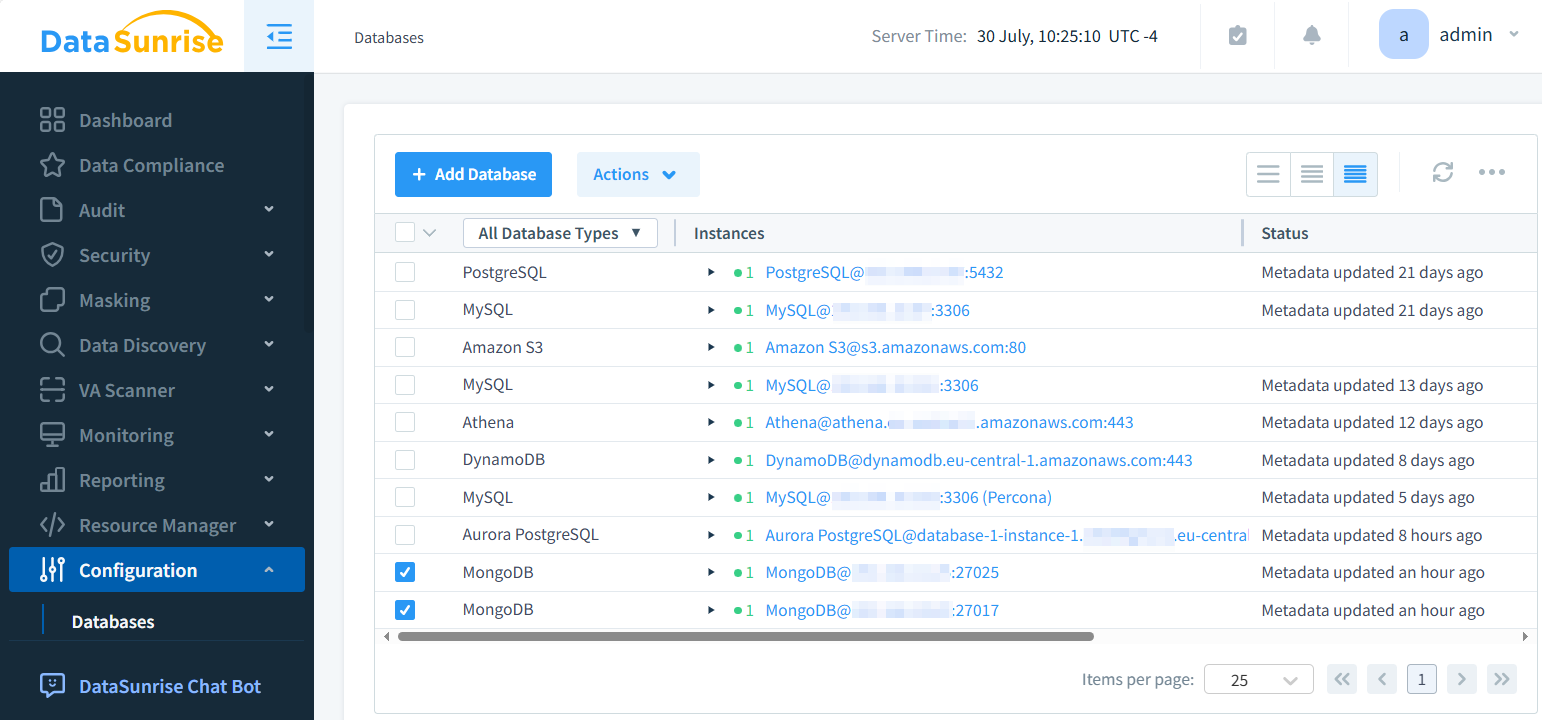
Viewing Statically Masked Data
Once configured, DataSunrise creates a masked copy of your database. To view the masked data:
- Set up static masking Task with the instances created earlier.
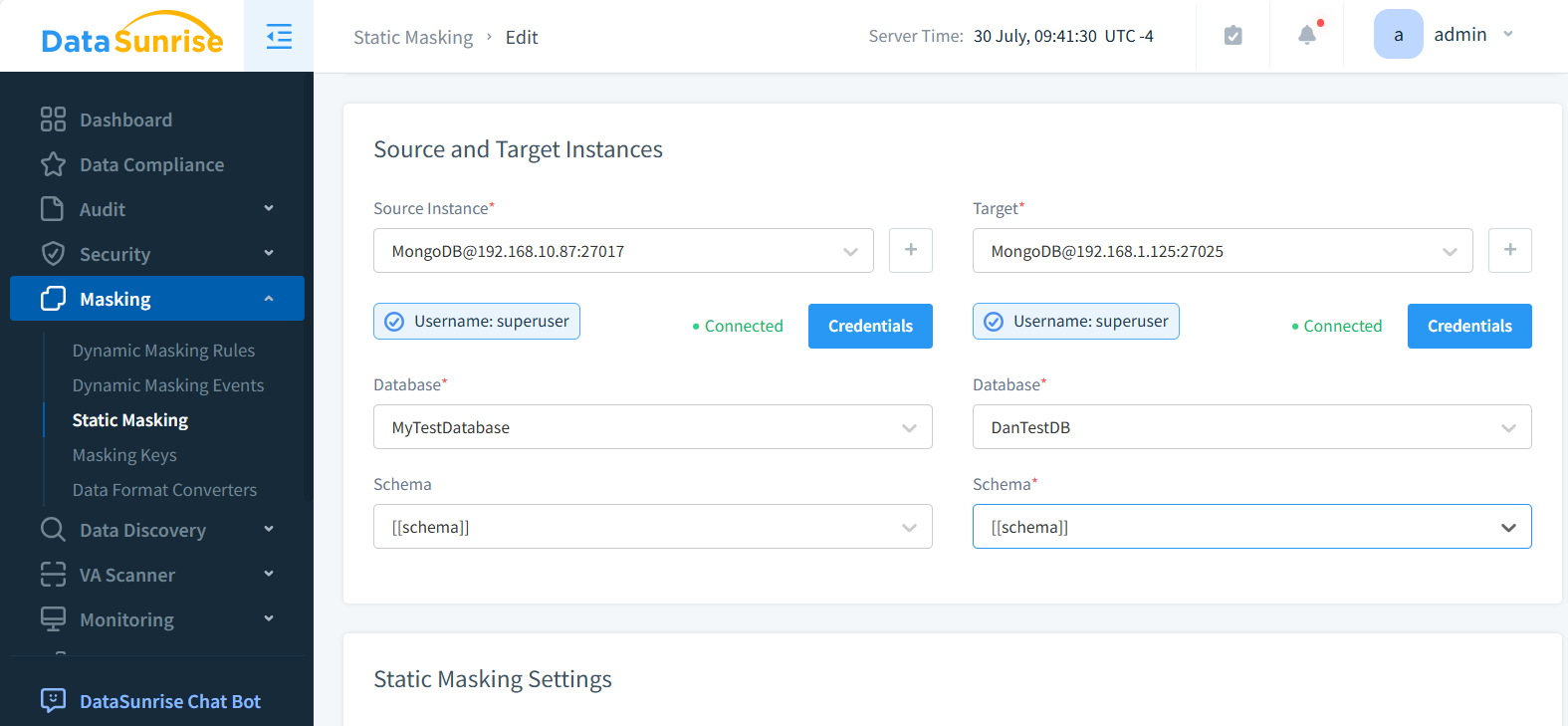
- Select the data to mask and masking methods.
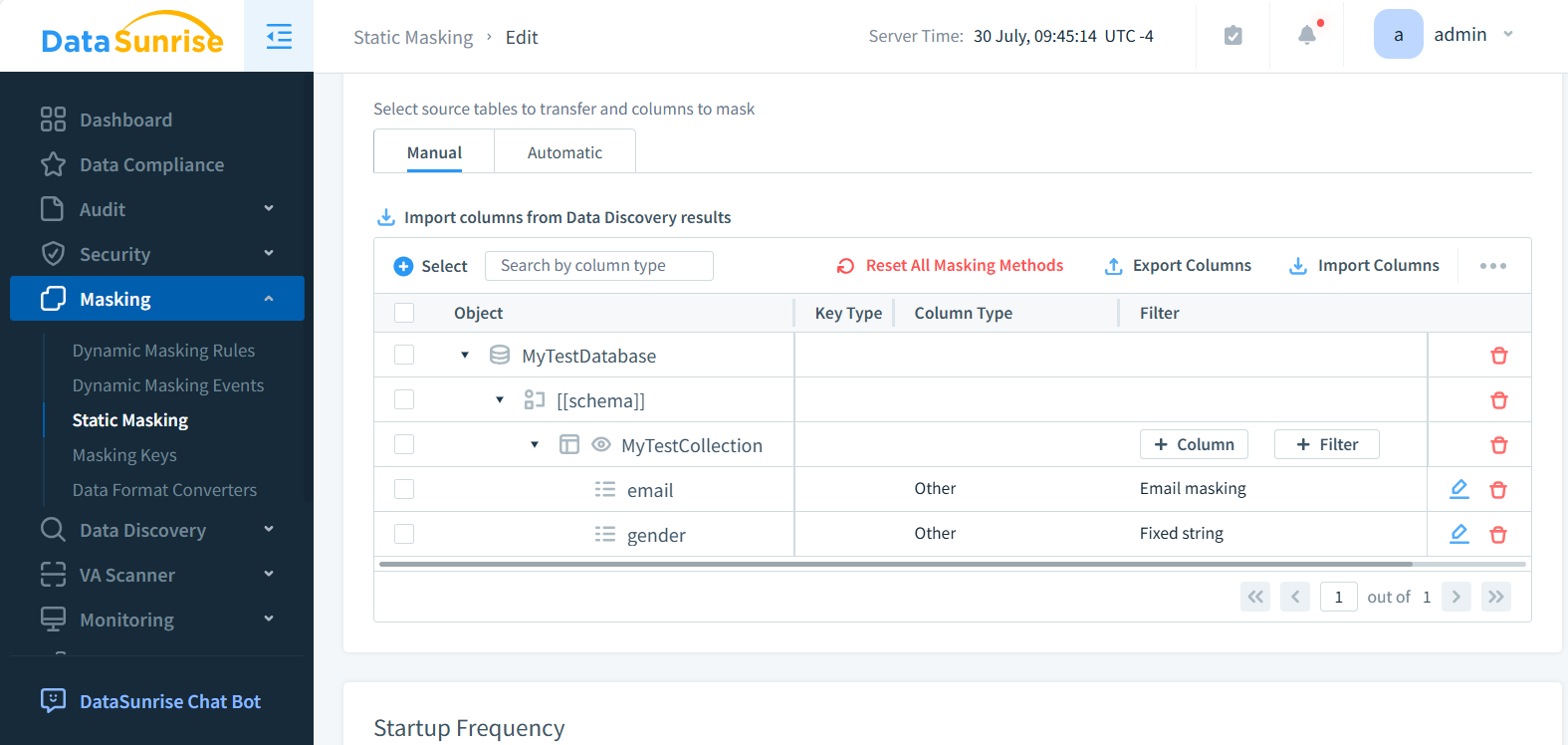
- Save and Run the Task. Then query the target database. It should contain masked data:
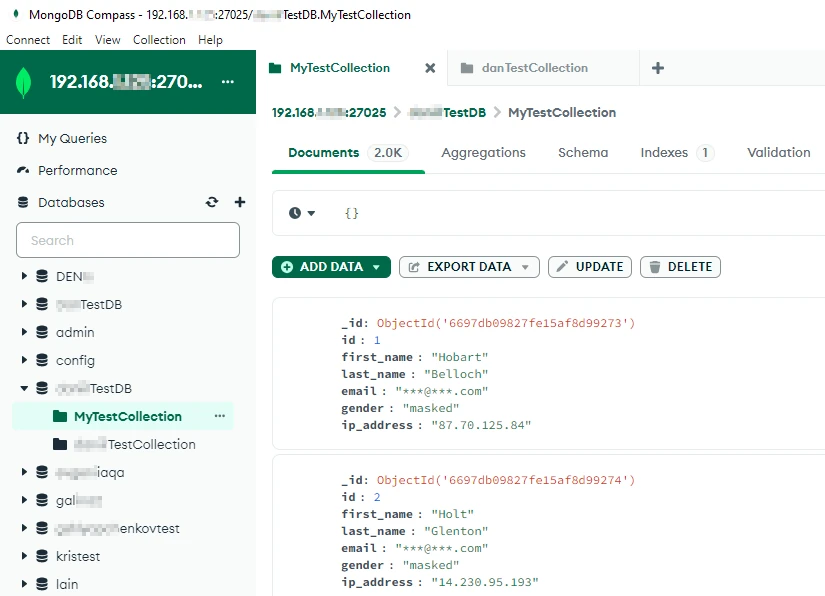
This article also introduces MongoDB in-place masking, a key enhancement from our previously published article.
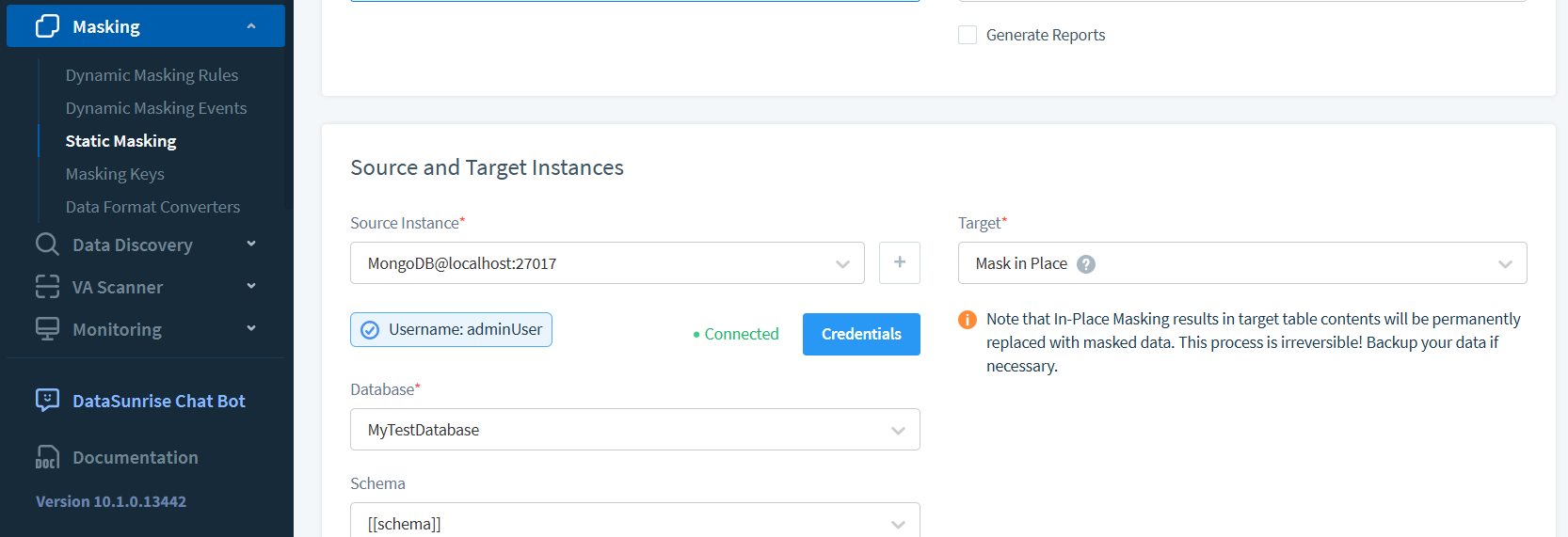
DataSunrise offers more advanced masking techniques, such as:
- Consistent masking across related fields
- Preserving data format and referential integrity
- Customizable masking algorithms
Benefits of Static Data Masking for MongoDB
Enhanced Data Security
Static data masking significantly reduces the risk of exposing sensitive information. It allows you to use realistic data in non-production environments without compromising confidentiality.
Regulatory Compliance
In today’s digital age, the protection of personal data has become a top priority for organizations across various industries. As more rules are created to protect data privacy, organizations must take steps to keep sensitive information safe. This includes following laws like GDPR and CCPA.
By implementing static data masking, organizations can comply with regulatory requirements and mitigate the risk of data breaches or unauthorized access to personal information. This not only helps protect individuals’ privacy but also safeguards the organization’s reputation and avoids potential legal consequences.
Static data masking is important for organizations to protect personal data while still allowing realistic testing and development. It helps balance the need for privacy with the need for effective data management.
Improved Development and Testing
With masked data, developers and testers can work with realistic datasets without the risk of accidentally exposing sensitive information. This leads to more accurate testing and better quality assurance.
Best Practices for Static Data Masking
- Identifying all sensitive data fields is crucial in order to effectively protect sensitive information. This includes personally identifiable information (PII) such as names, addresses, social security numbers, and financial information. Once these sensitive data fields have been identified, it is important to choose appropriate masking techniques for each data type. Masking techniques may include techniques such as encryption, tokenization, or data anonymization.
- It is also important to ensure consistency across related fields when masking data. If certain data fields are connected, they should be hidden in the same way to keep the data accurate.
- Regularly updating masking rules to address new data types is essential in order to stay ahead of potential security threats. As new types of data come out, it’s crucial to check and improve masking methods to make sure all sensitive data is safe.
- It is important to keep referential integrity in masked datasets. This ensures that relationships between data elements remain intact even after masking. This helps to maintain the accuracy and usability of the data.
- Implementing access controls for masked databases is crucial to ensure that only authorized users have access to sensitive information. Put access controls in place to limit who can see or change masked data. Only people with the right permissions should be able to access it.
Challenges and Considerations
While static data masking offers numerous benefits, there are some challenges to consider:
- Performance impact during the masking process
- Maintaining data relationships and integrity
- Ensuring masked data remains useful for testing
- Keeping masking rules up-to-date with changing data structures
Future Trends in Data Masking
As data protection becomes increasingly important, we can expect to see:
- More advanced AI-driven masking techniques
- Integration of data masking with other security measures
- Increased focus on dynamic data masking for real-time protection
Conclusion
Static data masking for MongoDB is a powerful tool for protecting sensitive data and ensuring regulatory compliance. By creating sanitized copies of databases, organizations can safeguard confidential information while still leveraging realistic data for development and testing purposes. Implementing static data masking is important for data management and security strategies.
This can be done using MongoDB’s built-in features or tools like DataSunrise. Static data masking helps protect sensitive information by replacing it with fictitious data. This ensures that only authorized users can access the real data.
DataSunrise offers user-friendly and flexible tools for comprehensive database security, including audit, masking, and data discovery features. To learn more about how DataSunrise can enhance your MongoDB data protection, visit our website for an online demo and explore our full range of security solutions.
